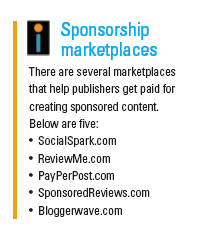Getting Into Website Sponsorships

Written By Ted Murphy ::
Our society has become saturated with traditional display advertising. Consumers have learned to tune out, or even pay to omit ads altogether.
The most glaring example of this can be seen in television. If you have seen an episode of NBC's "The Office" lately, you might have noticed product placement for Sandals Resorts, Apple, Gateway, Chili's, Cisco and many others. In the episode "The Merger," the character Kevin uses a Staples-branded shredding machine to shred a Staples branded CD-R and other non-paper items.
Product placement and sponsorship are appearing more than ever in radio, television and motion pictures. Each day the products and entertainment we love are becoming more entangled in each other's success. Naturally, the same advertising shift is taking place online.
A Familiar Problem
Advertisers have long understood the benefit of sponsored content - soap operas got their epithet because they were sponsored by soap manufacturers such as Procter and Gamble, Colgate-Palmolive and Lever Brothers. But content creators and networks moved away from this form of advertising because it limited inventory.
A show sponsorship can only be sold once, but distinctly separating content with commercials allows the ad inventory to be sold hundreds of times to different advertisers. Essentially, the networks got rid of custom sponsorship then created standard ad units and sold them all to the highest bidder. Initially, it worked. But the number of television and radio stations multiplied, niche content networks were created, and soon advertisers had thousands of options to promote themselves. Every network was selling the exact same thing, creating a commodity out of television and radio ad inventory.
|
|
|
 |
Readers! Please Note: This article was published in Website Magazine's special April edition. To view additional exclusive content from this issue, and to ensure you don't miss future editions (and the valuable content and ideas they contain), upgrade your account now to Website Magazine's professional membership level. Learn more at www.websitemagazine.com/prosubscribe/.
|
|
|
|
Now, in the online world, advertisers have millions of websites, blogs, podcasts and more in which to buy advertising space. While text links, banners and buttons may have generated a steady stream of revenue in the past, too many publishers supporting their network solely with advertising are struggling to stay afloat. CPMs and CTRs are dropping, while at the same time competition for online advertising dollars is growing. Unfortunately, many websites answer this challenge in the same way the networks once did - by adding more advertising.
What you end up with is websites overloaded with ads. Not only does this take away from the user experience but it can actually damage the brand. The ads compete with site content - and each other - driving down CTRs, page views and, ultimately, revenue. Adding more low-quality advertising to your site is not the answer.
Is Your Site Sponsor-Worthy?
The biggest difference between sponsorship and advertising is that sponsorships are almost always custom in some way. Instead of slapping a banner ad on your site, you are creating a unique promotion that leverages your brand and your audience. Think of your sponsor as a business partner; the more value you can provide, the more they will be able to compensate you now and in the future.
 Sponsors come in many shapes and sizes, but they all have one thing in common - they are selective. Buying media on an ad network is one thing, but partnering with a publisher on a sponsorship deal is entirely different. Potential sponsors will want to know that their brand is well-represented, and in tight correlation with the audience. Advertising budgets are being watched closer than ever before, so sponsors will look closely at your website and your audience to make sure they are getting the best return on their investment. As such, you should always have up-to-date, accurate analytics data available before approaching any potential sponsor.
Sponsors come in many shapes and sizes, but they all have one thing in common - they are selective. Buying media on an ad network is one thing, but partnering with a publisher on a sponsorship deal is entirely different. Potential sponsors will want to know that their brand is well-represented, and in tight correlation with the audience. Advertising budgets are being watched closer than ever before, so sponsors will look closely at your website and your audience to make sure they are getting the best return on their investment. As such, you should always have up-to-date, accurate analytics data available before approaching any potential sponsor.
If you are running a low-quality site that is nothing more than search fodder, don't waste your time trying to get sponsorships. However, if you have an attractive site with a solid community, you have a variety of options from which to choose.
Sponsored Content
Do you enjoy reviewing products and services? Is this something your audience will find interesting? If so, sponsored content might be a perfect fit. Generally speaking, advertisers will pay you to review or promote their product(s) on your site - anywhere between $5-$5,000 and more for a single article or blog post, generally depending on traffic and demographics. So it makes sense that blogs are a natural fit for sponsored content, as are those sites not considered to be official news sources.
As with any blog or magazine-style site, your audience is your biggest asset, especially when you are being paid to reach out to them. Therefore, you need to take steps to keep them happy. That includes full disclosure when writing sponsored content. Avoid a conflict of interest by notifying your readers that you are being paid to write a particular piece of content, even if you would have written about it anyway, or already wrote about it in the past. Readers are more willing to not only tolerate, but actually read sponsored content when treated with respect. Of course, any piece of sponsored content should be highly relevant to your audience and provide some sort of value.
Site Sponsorship
If you have successfully built a notable brand for your website, you may be able to land a site-wide sponsorship deal. In this arrangement, a sponsor pays for exclusive rights to advertising on your website - eliminating any competition while branding their product with your audience on an every-visit basis.
|
|
|
 |
Competitive Analysis for Sponsorships: Whether you are seeking a sponsorship for your site or an advertiser looking for a site to sponsor, a quick analysis of competitors and the site in question can help locate a target.
|
|
|
|
If you are considering site sponsorship it is imperative to align yourself with the right advertiser –- the brand you choose as your sponsor is a reflection of your own website's brand. In addition, you want to choose a brand that will perform well, given your audience. And you're not the only one looking for performance. The better your sponsorship performs, the more likely the advertiser is to re-up in future months. It also increases the chances for other advertisers to take notice and make competing offers.
Elemental Sponsorship
Instead of site-wide sponsorship, you also have the option of getting a sponsor for a particular portion of your site or a specific promotion, such as contests, awards and events. As a publisher, a targeted offer or section of content can be very enticing to the right sponsor. This type of sponsorship can be seen regularly during sporting events in the form of sponsored half-time reports, time-outs, post-game shows, etc.
While sponsored sections can be found on websites, contests are the most prevalent form of elemental sponsorship. Typically, a publisher is provided with a free product or service as a give-away from the sponsor in a co-branded promotion. The offer may or may not include addition cash compensation for the publisher, depending on the size of the site and the sponsorship terms. Contests of this type provide additional awareness for the advertiser, traffic for the publisher and a prize for readers, creating a mutually beneficially relationship. Seek out sponsored contest aggressively. Users love getting something free and will come back for more. It's also a great opportunity for publishers to collect demographic data from users.
It's a Balancing Act
The best sites find the right balance between content and advertising. But beyond the simple ratio, you need to consider the type of advertising and the impact on the site visitor. Sponsorship can allow you to get rid of some or all of the under performing display ad units and replace them with a more engaging experience that keeps advertisers coming back for more. As an added bonus, your site visitors will get fewer, but more relevant ads, and not be forced to negotiate your site like an advertising mine field. In the end, you will have happier users and a sustainable advertising model.
About the Author: Ted Murphy is Founder and CEO of IZEA, which operates PayPerPost and SocialSpark, and Executive Producer of RockStartup, an online docu/reality television show about running a startup business. He is also a frequent speaker at industry trade shows.

Subscribe to Our Newsletter!
Latest in Marketing








